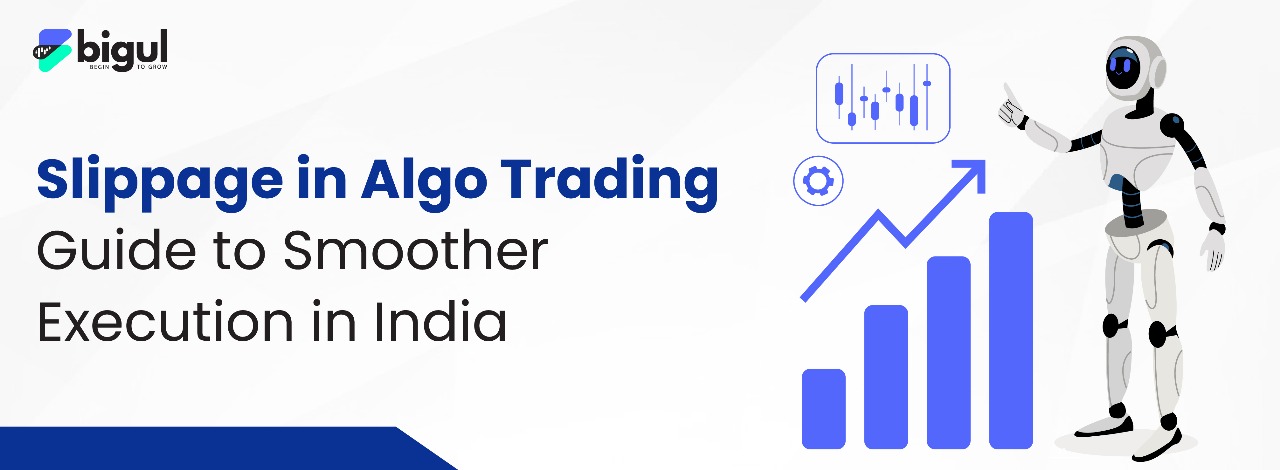Have you ever been glued to the screen, watching the market for hours, and thought, 'How can I benefit from the market without sitting for long hours?' The answer is algo trading. Algo trading is essentially computer programs used to automate trades and remove manual and emotional biases from investing.
In Algo trading, one of the major key factors is slippage. It is basically the gap between expected and actual execution prices. Let’s understand how a trader can remove slippage from its trades and execute the trades using Algo trading software carefully.
What Is Algo Trading?
Algo trading transforms how a trader or investor interacts with the markets with the help of computer programs. In algo, there is no need of manual execution. The algorithmic trading software can help to scan real-time data and spot opportunities. Algorithmic trading software eliminates emotional biases and helps to execute trades efficiently.
Algorithmic trading software handles everything from analysis to execution, making trading much easier for novice traders. Trading with algo Software means outsourcing the heavy lifting to the computer. Whether you're a novice or pro, understanding algo trading is foundational for modern finance.
Modern algo trading software comes in various forms, from sophisticated institutional platforms to user-friendly algorithmic trading apps designed for retail traders. These algo trading apps make it possible for individual investors to trade with algo without extensive programming knowledge. Meanwhile, many modern algorithm software for trading solutions offer visual programming interfaces that allow traders to create strategies without extensive coding experience.
One crucial concept that every trader must know is that Algo trading software may cause slippage due to market volatility, low liquidity or delay in order execution.To define slippage more precisely: it's the cost of market impact when your order moves the price against you. Order slippage can significantly affect profitability, especially in high-frequency trading strategies.
Let's understand in detail what slippage is and how viable Algo Trading is in the context of the Indian market.
What Is The Viability Of Algo Trading In The Indian Stock Market?
India's embrace of algo trading truly took off after SEBI introduced its thoughtful regulatory framework, carefully balancing market innovation with essential integrity. Leading brokers like Bigul have been pivotal, developing incredibly user-friendly algorithmic trading apps and algo trading apps.
These platforms have actually democratized the entry, gripping advanced algo-trading software that have gone directly into the hands of people who may never have had a chance to code in the past. In one moment, the practical use of complex algo trading algorithms or even creation of a simple algorithmic trading programme were much more feasible. However, at this point the question which hangs in the air is, does it pay to trade using algo consistently in this market?
The straight answer is YES, but of course it depends on quite a number of things. Profitability does not just come as it requires combining efficient, thoroughly tested algo trading algorithms with uncompromised data quality in the markets.Crucially, traders must proactively manage hidden costs that can silently erode gains, with slippage in algo trading being a major one.
Slippage, or order slippage, occurs when the actual execution price of a trade differs from the expected price – often due to rapid market movements between order placement and fulfillment. It is simply the difference between where you thought you'd get filled and where you actually did.
While powerful algorithm software for trading empowers traders immensely, viewing it as a magic solution is a mistake. Success demands continuous learning and adaptation – understanding not just what algo trading is, but how it works under real-world pressures.
SEBI's strict oversight ensures a level playing field, allowing you to trade with algo confidently. It is achieved with disciplined and measured strategy improvement, careful risk management (particularly of slippage), effective use of smart tools, and an unwavering determination to stay up to date in the changing market (not just learning and growing via reputable books and courses).
What Is Slippage In Algo Trading?
Picture this: your algo software identifies a buy signal through crunching numbers at lightning speed. Your order comes at Rs 100, but the reality bites, your confirmation shows a final price of Rs 100.50. That frustrating 50 paise gap? That's slippage in algo trading in action.
Simply put, slippage is the unavoidable friction between the price you expect and the price you actually get when your trade executes. It's the difference between the intended execution price and the real, actual execution price. This order slippage isn't just an abstract annoyance; it's real money leaking from your potential profits or adding to your losses, silently chipping away at your edge.
Slippage in trading is primarily driven by market dynamics moving faster than orders can be filled. Imagine trying to buy a rare collectable at an auction just as bidding explodes – the price you hoped for vanishes instantly. Similarly, high volatility, like during an earnings surprise or major news event (e.g., Nifty crashing 2% in minutes), causes prices to jump erratically. Even tiny delays in order routing, measured in microseconds for high-frequency algo trading algorithms, can be enough for the market to move against you.
Consider this relatable example: You want to buy 10,000 shares of "XYZ Ltd," currently quoted at Rs150 (bid) / Rs150.50 (ask). Your algorithm signals a market buy. In a calm market, you might get filled near Rs150.50. But if negative news hits just as your order hits the exchange, the only available sellers might now be at Rs151.00 or higher. Your actual execution price could average Rs151.25 – that's Rs0.75 per share of slippage, costing you Rs7,500 instantly!
Research has estimated that the average costs of slippage may be 5-20 basis points per trade (0.05-0.20 percent), However, in event volatility such as the 2020 market crash, or a "flash crash," slippage can reach 1 or more. On a 1-crore institutional order, a slippage of just 0.10 per cent results in a 10,000-rupee loss that is non-recoverable and has to be borne straight away. Certain brokers will also explicitly charge a slippage fee in case of execution, making it not within the guaranteed parameters.
Understanding the slippage meaning in trading is crucial because it transforms theoretical strategy returns into practical, real-world performance. Unmanaged slippage can easily halve that figure. It's the chaotic reality of order books, where thousands of orders collide, and prices shift continuously.
How To Avoid Slippage In Algo Trading?
Minimising the relentless drain of slippage in algo trading starts with deliberate, tactical choices embedded within your algorithmic trading software. First, ditch the immediacy of market orders for the control of limit orders—this simple swap caps your maximum acceptable entry or exit price right within your algorithm software for trading, preventing nasty surprises.
Imagine that your algo trading algorithms are screaming buy; a market order could snatch up shares at 102 rupees (what you were wanting is 100), but with a limit order of 100.50, slippage in the order is avoided, and you are paying every extra penny, which will counteract order slippage directly.
Second, execute with complex algorithms, e.g. VWAP (Volume Weighted Average Price) or TWAP (Time Weighted Average Price). These super-efficient ones in your algorithmic trading app went automatically slice giant ones that affect the markets, say, the buy of 50, 000 shares, into puny, manageable steps that were executed in minutes or hours.This drastically reduces your footprint and price impact, a core strategy when trading with an algo at scale.
Studies show VWAP strategies can reduce slippage by 0.15% to 0.25% on large institutional orders compared to a single market order – that’s saving $1,500 on a $1 million trade!
Third, algo trading is all about the time. Program your algorithmic trading tool to operate most of the time when liquidity is high, i.e. when the maximum volume is traded in the market i.e. at the peak time of the session (e.g. 11:30 AM to 2:00 PM IST at NSE). One should stay away during opening bells (9:15 AM) and this is when the auction market experiences volatility when closing (3:20 PM onwards) due to thin order books.
Fourth, collaborate with brokers that will provide you with real Direct Market Access (DMA)
Fourth, partner with brokers offering true Direct Market Access (DMA). This bypasses internal broker systems, shaving off critical milliseconds and ensuring your orders generated by your algo trading programming hit the exchange faster, reducing latency-induced slippage.
Remember, slippage worsens dramatically with overly aggressive strategies; sometimes, patience embedded in your algo trading algorithms trumps raw speed. For trade with algo practitioners, understanding slippage meaning in trading is key: it's the difference between theoretical backtest results and real-world P&L. By implementing these steps—limit orders, smart execution algos, strategic timing, and DMA—you actively manage the slippage fee, transforming it from a silent profit-killer into a quantifiable, controllable variable. Slippage is not just as a cost, but as a challenge your algorithmic trading software is explicitly designed to overcome, boosting your bottom-line confidence.
How To Trade Profitably Through Algo Trading?
Trading profitably with algo trading hinges on seamlessly integrating powerful technology, robust strategy development, and disciplined execution – all centered around minimizing costs like slippage. The foundation is selecting top-tier algorithmic trading software or a reliable algorithmic trading app. This algorithm software for trading is your command center; it must offer lightning-fast execution, sophisticated backtesting capabilities against vast historical datasets, and seamless integration with live market data feeds and your brokerage.
Platforms like MetaTrader (MQL), Python libraries (Backtrader, Zipline), or dedicated institutional-grade algo trading software (like Bigul) empower your algo trading programming efforts. Within this software, you develop and deploy your algo trading algorithms – the core logic dictating entries, exits, position sizing, and crucially, execution tactics. Understanding algo trading fundamentally involves recognizing it's not magic; profitability stems from rigorously tested strategies (trend following, mean reversion, arbitrage) coded into your algorithmic trading programme and constantly refined based on real-world performance and market shifts.
In addition to strategy coding, the high quality and low latency market data is needed to engage in profitable trading with algo. Low-latency data makes sure your algorithmic trading software responds to the movement of the markets in near real-time which is a very important distinction as, in most situations, milliseconds can spell the difference between making it and slipping a price. Most important is the quality of execution. Top Algo trading applications these days have built-in smart order routing (SOR) and even some sophisticated execution algorithms (such as VWAP, TWAP, Implementation Shortfall). These are very useful instruments against slippage in algo trading, particularly with regards to bigger orders, through intelligent order slices and directing them to markets where they can receive the best available price and work to minimize market impact and slippage.
Furthermore, robust risk management modules within your algorithmic trading software are non-negotiable. These automatically trigger stop-losses, position limits and drawdown limits to ensure that your capital is safe during any unexpected volatility event that may occur, a very important element that traders too often ignore when beginning to trade with algo.
Synergistic thinking is ultimately the best solution to profitable algorithmic trading, which is to utilize high-performance algorithmic trading software, endorsed with superior backtesting and "live" monitoring; coupled with high-quality, low-latency market data. Meanwhile, sound trading strategies developed and thoroughly tested into your trading algorithms; execution intelligence targeted to avoid both slippage and cancellation; and automate aggressive risk management.
Meanwhile, these high-level tools are easy to work with by carefully selecting and mastering best-in-class tools and relentlessly reduce friction like slippage so that you make algo trading not a complicated computerized activity but a highly effective machine that turns small, consistent data-driven profits in this ever-changing financial market.
Conclusion
Slippage in algo trading is like road friction for a race car: inevitable but manageable. By understanding its roots—volatility spikes, liquidity gaps, or order size—you can mitigate risks. Smart algorithmic trading software, limit orders, and liquidity-aware timing form your defence toolkit. Trading with algo in the Indian crowded markets requires a skill to achieve strategy design as well as execution finesse. Remain alert, turn the instruments such as algo trading apps to your way and make slippage not an enemy but a parameter that one will outwit.
FAQ
Q: Do algo trading strategies really work?
A: Algo trading definitely works if it is designed carefully. Algo trading algo exploits market inefficiencies consistently and free of human emotion. Algo trading also requires constant tweaking and real-world validation.
Q: What is the average slippage cost?
A: Slippage varies wildly. In liquid large-caps, expect 0.1–0.3%. For volatile small-caps or derivatives, it can breach 1%. Using algorithmic trading app features like limit orders or VWAP reduces this significantly. Always factor slippage fee into risk models.
Q: Can beginners start algo trading?
A: Yes! Platforms like Bigul simplify algo trading programming. Start small—paper trade first, master backtesting, then scale live. Focus on learning logic, not just profits. Algo trading is a skill built step-by-step.
Q: Is slippage always negative?
A: Surprisingly, no! Slippage can be positive (e.g., buying lower than planned during a dip). But prudent algorithmic trading plans assume negative order slippage to safeguard margins.
Q: How important is broker choice for minimising slippage?
A: Critical. Brokers with low-latency infrastructure and smart order routing slash slippage in trading. For high-frequency algo trading apps, this tech edge directly impacts profitability. Never compromise on execution quality.


.jpg)






.jpg)
.jpg)
